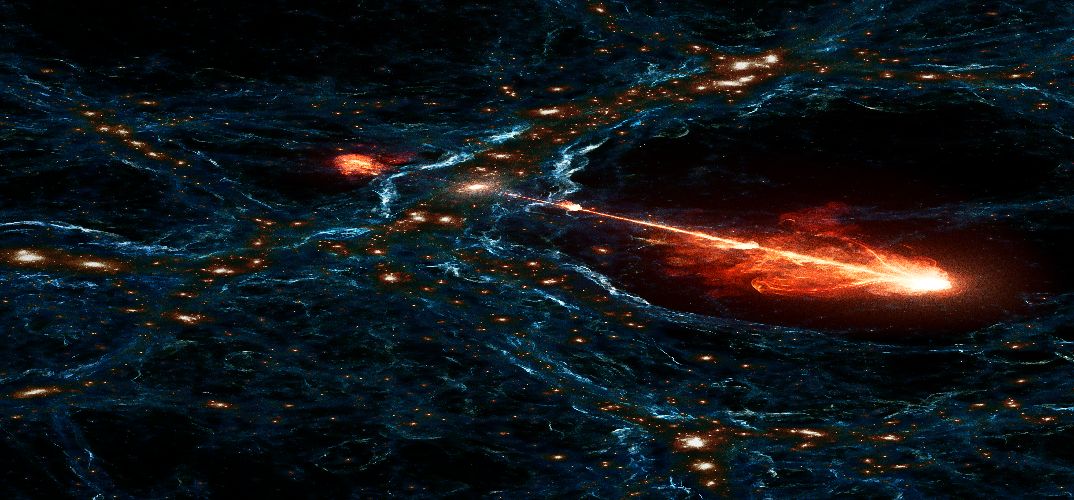Herts astrophysicist helps uncover 10,000 black hole jets including biggest ever seen, 7.5 billion light years away

A University of Hertfordshire astrophysicist has played an important role discovering the biggest pair of black hole jets ever seen, spanning 23 million light-years in total length: the equivalent of lining up 140 Milky Way galaxies back-to-back.
Professor Martin Hardcastle, an expert specialising in radio astronomy and high-energy astrophysics, has co-authored a new paper in Nature reporting the research, which was led by Martijn Oei, a Caltech postdoctoral scholar.
The gargantuan jet system is the biggest found so far during a sky survey that has revealed an astounding number of the faint megastructures: more than 10,000. The massive population of colossal jets was found using the Europe's LOFAR (LOw Frequency ARray) radio telescope. Large jet systems were previously thought to be rare and on average the ones previously found were smaller in size than the thousands of systems uncovered by the radio telescope.
"These giants were known before we started the campaign, but we had no idea that there would turn out to be so many," says Martin Hardcastle, second author of the study. "Usually when we get a new observational capability, such as LOFAR's combination of wide field of view and very high sensitivity to extended structure, we find something new, but it was still very exciting to see so many of these objects emerging."
The jet megastructure, nicknamed Porphyrion after a giant in Greek mythology, dates to a time when our universe was 6.3 billion years old. Data from the W. M. Keck Observatory in Hawai‘i showed Porphyrion to be 7.5 billion light-years from Earth, which means it existed when our universe was less than half its present age of 13.8 billion years.
These fierce outflows—with a total power output equivalent to trillions of suns—shoot out from above and below a supermassive black hole at the heart of a remote galaxy. Outside assistance established the home of the jets was a hefty galaxy about ten times more massive than our Milky Way.
Systematically searching for more hidden jets led the team to employ three different methods: inspecting the radio images by eye, using machine-learning tools to scan the images for signs of the looming jets, and enlisting the help of citizen scientists around the globe to eyeball the images further.
Keck Observatory revealed that Porphyrion emerged from a radiative-mode active supermassive black hole, not a jet-mode state. Radiative-mode supermassive black holes were more common in the early universe; jet-mode ones are more common in the present-day universe.
Astronomers were surprised that a radiative-mode supermassive black hole could produce such huge and powerful jets. And because Porphyrion lies in the distant universe where radiative-mode supermassive black holes are more common, the finding implies there may be a lot more colossal jets left to be found.
Martin Hardcastle, Professor of Astrophysics at the University of Hertfordshire, said:
"Martijn Oei's work has shown us that there isn't anything particularly special about the environments of these giant sources that causes them to reach those large sizes.
“My interpretation is that we need an unusually long-lived and stable accretion event around the central supermassive black hole to allow it to be active for so long—about a billion years—and to ensure that the jets keep pointing in the same direction over all of that time. What we're learning from the large number of giants is that this must be a relatively common occurrence."
How the jets can extend so far beyond their host galaxies without destabilizing, however, is still unclear.
Lead author Dr Martijn Oei, says the team’s next step is to better understand how these megastructures influence their surroundings.
The jets spread cosmic rays, heat, heavy atoms, and magnetic fields throughout the space between galaxies. Oei is specifically interested in finding out the extent to which these giant jets spread magnetism.
"The magnetism on our planet allows life to thrive, so we want to understand how it came to be," he says. "We know magnetism starts in the cosmic web, then makes its way into galaxies and stars, and eventually to planets, but the question is: Where does it start? Have these giant jets spread magnetism through the cosmos?"
It is not the first time that the University of Hertfordshire has recorded significant research findings in the field of astrophysics.
Herts researchers have made significant discoveries on the composition of far-off galaxies, the furthest ever detection of a galaxy’s magnetic field, the history of our nearest galaxy, and hidden stars at the heart of our Milky Way. It has some 50 research astrophysicists on its staff, and 30 postgraduate students also researching astrophysics. It has one of the country’s best-equipped teaching observatories, at Bayfordbury.
In May, a former Herts postgraduate student, Dr Beatriz Mingo, was awarded a prestigious Ernest Rutherford Fellowship for her breakthrough research on new populations of black-hole jets. She has now taken up her Fellowship place at Herts.
Read about astrophysics at Herts
The Nature study, "Black hole jets on the scale of the cosmic web," was funded by the Dutch Research Council, the European Research Council, the U.K. Science and Technology Facilities Council, the UK Research and Innovation Future Leaders Fellowship, and the European Union. Other Caltech authors include graduate student Antonio Rodriguez and Professor of Astronomy and Data Science George Djorgovski. Additional authors are Roland Timmerman, Reinout J. van Weeren, Huub J.A. Röttgering and Huib T. Intema of Leiden University (Timmerman is also affiliated with Durham University); Aivin R.D.J.G.I.B. Gast of the University of Oxford; Andrea Botteon and Francesco de Gasperin of the Institute for Radio Astronomy of Italy's National Institute of Astrophysics; Daniel Stern of the Jet Propulsion Laboratory, which is managed by Caltech for NASA; and Gabriela Calistro Rivera of the European Southern Observatory and the German Aerospace Center.